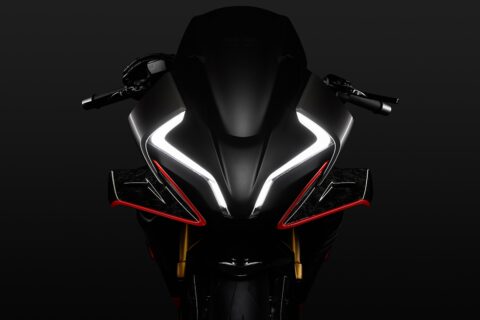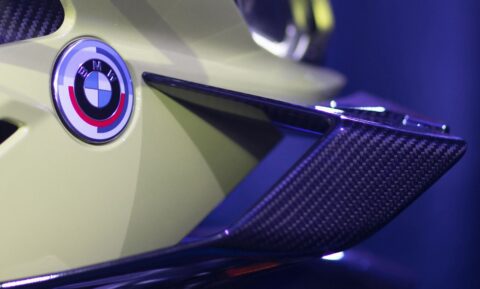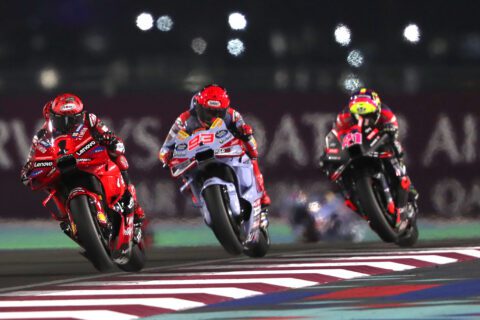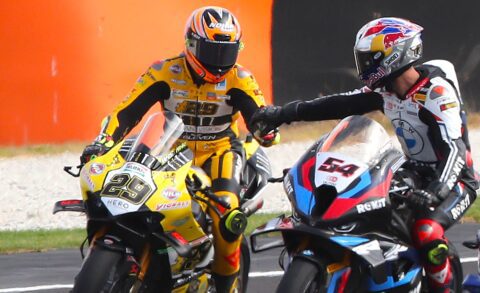As your grandad will tell you the telescopic fork first appeared on motorcycles shortly after the turn of the last century. 1908 in fact on a Scott, but it took a while for those fork legs to gain proper damping of any sort and certainly it took a long while before they began to bear any resemblance to those sophisticated springers we use up front today.
Those springers (or more commonly called forks legs!) remain a very simple design but a very well developed piece of your motorcycle which has been honed through decades of racing R+D. Depending on what type of suspension is fitted to your bike it is true to say the likes of Spencer, Doohan, Rainey and Rossi are responsible for just how good it all works under you.
But how do they work? We spoke to those clever people at Ohlins Racing and Bob Gray from MSS Colchester Kawasaki;
Looking at it very simply, the two tubes which attach your front wheel to your headstock each contain a spring, a damping rod and some oil. Although several other types of front suspension exist the telescopic forks remains the favourite because it is relatively cheap to produce (tho’ you might not think that when you get your bill for the fancy race forks you’ve just, err, forked out on), are relatively light weight and crucially offer the rider better feel for the front tyre grip.
Understanding how suspension works is straightforward enough and it helps to begin with if you can visualise what is happening. When your forks compress they get shorter of course, but it is the headstock getting closer to the front spindle that is the important part and not the other way around. As the forks move down the front half of the chassis moves inwards. Suspension is all about keep that tyre gripping and helping your bike turn so that downward movement of your headstock and the inward movement of the front wheel are what we rely upon for feel.
The role of the front fork is to support the weight of the rider and bike as they ride over bumps, brake and accelerate. They do that by holding you up with a spring and controlling the up and down movements of that spring with oil and a damping rod. Adjusting the stiffness of the spring, the weight of oil, the quantity of oil and how freely that oil can flow within the damper are the common ways of adjusting your suspension.
Springs are important because they hold the fork extended and hold the weight of bike and rider – without them the bike would simply collapse. So having the right spring (usually called spring rate) is important because if it’s too hard the forks sit fully extended and don’t move, too soft and you’re forever hitting the buffers and have no suspension movement either. On road bikes with standard suspension, the springs and damping rates are a compromise between every possible load (thin rider, fat rider, pillion, luggage, etc) and road or track condition. In itself that is a very tricky and clever achievement but it does mean they often don’t work too well on track where more force is applied. Which is why many of us opt for an upgrade.
Damping is the control of the springs. Without it the springs would just keep springing endlessly. Most of you reading this will likely have adjustable damping on your bikes which normally controls compression and rebound. Quite simply the compression damping controls the rate at which the fork compresses, the rebound controls the rate at which it extends. Adding more damping slows down the rate of movement, taking it away speeds it up. Simple.
Fork units normally have two ways of controlling compression damping, high and low speed. Low speed damping is the most common accessible form of adjustment (usually a screw on the outside of the fork leg, at the bottom for compression and on the top for rebound) while high speed control is normally adjusted internally. This is a generalisation of course as some bikes come with adjustable high and low speed damping as standard and certainly many of you will have aftermarket fork fitted, which are likely to also have this control externally. Standard bike suspension, while very good these days, generally doesn’t have enough range of damping control which is why we look to aftermarket, race-bred products to tailor our bikes to our needs.
But back to the explanation. It’s important to realise there are two methods of controlling compression damping and rebound damping in each fork leg; called high and low speed damping. Low speed control affects the small movements of the fork legs and it’s this which most of us attribute to ‘feel’. It controls small movements of oil and is easily felt by bouncing the forks at a standstill. High speed compression on the other hand needs a stronger force or weight and, because you therefore have asked for a larger amount of oil to be moved more quickly, the clever damping system switches to a second way of controlling the movement to allow more volume of movement.
Bob Gray – MSS Colchester Kawasaki said “It’s a bit like asking a conference hall full of men to leave the building. Imagine the people are the oil and the exit doors are the damping circuits. If there’s no hurry, we can ask people to slowly exit through one small door – and because of this we can accurately control them. But if someone at the back shouts ‘naked women in the foyer’ there will be a problem. We’ll quickly need to open the big door but there will still be control because the people can only get through the doors so fast – the difference is there will be control at higher speed (or volume).”
It is worth noting that the overall stiffness of the front forks is also affected by the oil level, which provides a form of pneumatic spring rate due to compression of the air above the fork oil level. Compared to conventional style front forks, upside down forks are very sensitive to variations in oil level so care must be taken when performing any internal changes to the forks that the oil level is set to the correct height. A change in the front fork oil level will not affect the air spring force in the early stage of the movement, but will have a greater effect in the later stage. If the oil level is set too high, the air spring in the later stage of travel is stronger, thus the forks are harder and vice versa if the oil level is too low.
The other aspect to get your head around is spring rate and preload. The spring rate is adjustable of course but internally, simply by switching springs. The preload is normally adjustable by the larger adjuster on top of your fork legs. Spring rate describes stiffness and is given as a force and a linear measure. So hearing someone describe a 10kg spring (in effect 10kg/mm), means for every 10kg of load that spring will compress by 1mm.
The load and spring rate are also what determine the amount of sag on your bike. Sag is how much suspension travel is used when supporting the bike’s weight (without the rider). Preload is the way we adjust sag so in the case of an 8kg/mm spring for example on one particular bike we may have 12.5mm sag so if we have only 10mm of sag we will need to preload the spring, hence the term.
Over to Bob Gray again, “preloading a spring simply means compressing it before any load is applied. If we squashed an 8kg/mm spring into a box which was 1mm too small for the spring – the spring would think that is was supporting a load of 8kg (because something has squashed it by 1mm). So if we preload the springs in our suspension they think they’re carrying a weight and push back with the equivalent amount of force.”










